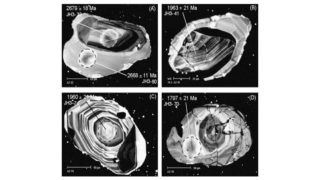Research

Fast automated mineral mapping by TESCAN Integrated Mineral Analyzer
Research and services
The John de Laeter Centre provides quantitative data used to understand processes of Earth and planetary evolution, characterise the nature of resources and materials upon which our society depends, and monitor our changing environment. The centre is open to collaborative research projects, non-collaborative access to the equipment by qualified users for research purposes, and commercial services.

Rock age determination by SHRIMP zircon U-Pb technique
Research consultancy and analytical services
- Rock crushing, mineral separation and mount preparation.
• Rock crushing (disc and WC ring mill, HV pulse disaggregation)
• Wilfley table, Franz and heavy liquid mineral separation
• SHRIMP and SEM grain mount preparation
• Sample polishing - Bulk sample and mineral characterisation
• Optical microscopy (transmitted and reflected)
• X-ray diffraction
• Minor, trace and ultra-trace element chemistry (HR-ICP-MS)
• Whole rock Sm-Nd and Pb-Pb isotopic tracing
• Stable isotopes (C, H, N, O) in air, water and solids - Geochronology and thermochronology characterisation
• U/Pb (zircon, apatite, xenotime, monazite, rutile, cassiterite, baddeleyite, uraninite, columbite)
• 40Ar/39Ar (mica, feldspar, clinopyroxene, K-sulfates, priderite, wadeite, tourmaline)
• Re-Os (molybdenite, sulfides, black shale, oil)
• (U-Th)/He (apatite, zircon) - In-situ surface microanalysis
• SEM (imaging, energy dispersive x-ray spectrometry and electron backscattered diffraction)
• ELA-ICP-MS (quantitative major, minor and trace elements)
• X-Ray photoelectron spectroscopy
• Small angle X-ray scattering - In-situ mineral and chemical mapping
• SEM (imaging, energy dispersive x-ray spectrometry and electron backscattered diffraction)
• ELA-ICP-MS (quantitative major, minor and trace elements)
• Atom probe tomography (3D trace elements) - Organic geochemistry analysis
• GC-IRMS/ CSIA (13C/12C, D/H) of natural gas mixtures, oils and organic extracts
• EA-IRMS (13C/12C, D/H, 15N/14N)
• 5A molecular sieving
• Gas Chromatography MS and PY-GCMS analyses
• Source of oil in the environment
• Hydropyrolysis of oils and sediments
• Source rock characterisation
• Age of oil
• Stranded bitumen/tar ball characterisation
• Bitumen I and Bitumen II methods
